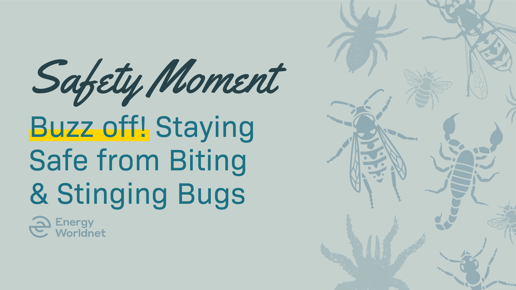2 min read
Safety Moment: Buzz Off! Staying Safe from Biting and Stinging Bugs
Energy Worldnet (EWN) : Apr 2, 2024 2:59:46 PM
As the weather gets warmer, pipeline workers across the United States face a small but perilous threat:
biting and stinging bugs.
 Although often overlooked, these tiny creatures can pose health and safety risks to workers in our industry.
Although often overlooked, these tiny creatures can pose health and safety risks to workers in our industry.
When working in areas known to shelter dangerous bugs, prioritizing safety is essential.
Bugs can expose workers to several specific hazards. While dangerous biting or stinging bug species will vary depending on the region, the hazards associated with bugs are generally the same.
Here are some of the most common hazards workers are exposed to:
-
Diseases
Ticks, common in wooded and grassy areas, are among the most dangerous bugs in the US. Workers risk contracting Lyme disease and other pathogens if bitten by a tick.
Another common disease-carrying bug is the mosquito, which can carry diseases such as the West Nile virus and Zika virus.
Furthermore, some species of biting flies (e.g., sandflies) may infect workers with parasitic pathogens.
-
Allergic Reactions
Although mildly venomous insects, like most species of ants, wasps, and bees, can be nuisances, they generally do not pose a significant risk to most workers. However, some workers may have life-threatening allergies to these insects.
The behavior of these insects will vary depending on the species, but there are some common traits between them. For example, most ants nest in the ground, posing a hazard in areas where workers walk.
Wasps and bees, on the other hand, build their nests on or inside trees or human-made structures.
-
Dangerous Venom
There are two types of spiders in the United States that have venom and can cause severe harm: the black widow and the brown recluse spider.
Black widow spiders may hide in sheltered areas of facilities, equipment, and debris piles where workers may reach without looking.
Brown recluse spiders, which are a less common risk, may still hide in sheds and old shoes or clothing.
Even though most other venomous bugs in the US are generally non-lethal, some species could still cause significant pain or distress, such as certain species of scorpions, stinging caterpillars, and highly venomous wasps and ants.
Don’t Let Them Bug You: Prepare for Bug Season
As more biting and stinging bugs emerge with the new season, there are many safety precautions workers can take. Start by familiarizing yourself with the types of harmful biting and stinging bug species in your region and wearing protective clothing accordingly.
If you have an insect allergy, bring appropriate first aid, such as antihistamines and an epinephrine auto-injector, to the job site.
When working on the field, always remember to take special care to identify and avoid any webs, nests, swarms, and other signs of dangerous bugs, and watch where you step or reach.
If you recognize a hazard or get bit or stung, communicate with your supervisor and follow emergency procedures if necessary.
EWN offers OSHA courses designed to ensure workplace safety, with references to applicable 29 CFR 1910 regulations. Looking to keep your staff safer on the job site? Click the button below to get your journey started with Energy Worldnet!

